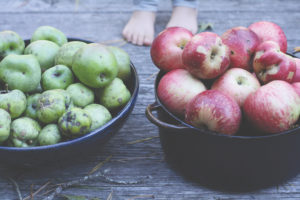A study published this summer in Science suggested trees are the best tool we have to stabilize our rapidly changing climate. We could increase the world’s forest cover by a third without affecting existing cities or agriculture, the researchers say, and cut atmospheric carbon dioxide by 25 percent, to levels last seen almost a century ago.
I’d be one to vote for more food-producing trees.
I’ve been thinking about this ever since my conversation with Restoration Agriculture author and farmer Mark Shepard. What he told us when he visited the Nauset Food and Research Garden (see the Independent, Oct. 10) was let’s grow food forests and raise animals and fungi beneath nuts and fruits and berries.
Especially apples, I say. At least that’s my thinking right now. If you look closely you’ll find some productive apple trees around the Outer Cape.

Ours is not an intentionally planted food forest, but even so, it’s abundant. The oaks put out acorns, a mainstay of the diets of many indigenous cultures, and clearly an excellent way to fatten up turkeys. Beneath the tallest trees and along roadsides we find black raspberries, blackberries, huckleberries, blueberries. Over the summer this year I picked gallons of wild berries and froze them for smoothies and pies.
Now I’m moving on to apple trees. There are a few I visit each fall — some cultivated, some gone wild. I like to make applesauce with my haul. And it’s the mix that makes a good sauce, one that hits every note an apple can play, from cinnamon, to floral, to tart, to sweet.
It’s time to put up applesauce for the winter, a small token of the promise of trees.
Applesauce for Winter

My mom always put up big batches of homemade applesauce. She froze hers, but I prefer to can it in glass jars, as space is at a premium in my chest freezer. I put up some big jars for opening at home, and some just the right size for packing in school lunches.
If you’re foraging apples go ahead and use ones with holes or brown spots — just be sure to cut these parts out before you put them in the pot.
apples
water
lemon juice
Let’s start with ratios: for every 3 pounds (roughly 12 cups, cut up) apples, you’ll want to add about 1/2 cup water to your pot. And for every 1 quart finished sauce you’ll need 1 tablespoon of lemon juice.
First wash the apples and cut them into quarters. Put them in a large pot, add the water, and bring everything to a boil. Turn the heat down to low and simmer, stirring often, until the apples are soft and begin to fall apart. Add more water if at any point the apples begin to get dry and stick to the bottom of the pot.
Put the cooked apples through a food mill into a bowl. Crank through batches until you have a big bowl of smooth applesauce, discarding the seeds and skins as you go.
Measure the applesauce (in cups) and return to the pot. Add one tablespoon lemon juice per quart of sauce — not all recipes say this is strictly necessary, but I like the flavor and I like to err on the safe side of adequate acidity.
Bring to a simmer, stirring often to prevent burning, and spoon the hot applesauce into sterile jars. Fill and seal the jars according to the manufacturer’s instructions, then process them for 20 minutes in a boiling water bath. Let the finished jars sit overnight undisturbed, then put them in a cool, dark place. The applesauce will keep for up to a year.
